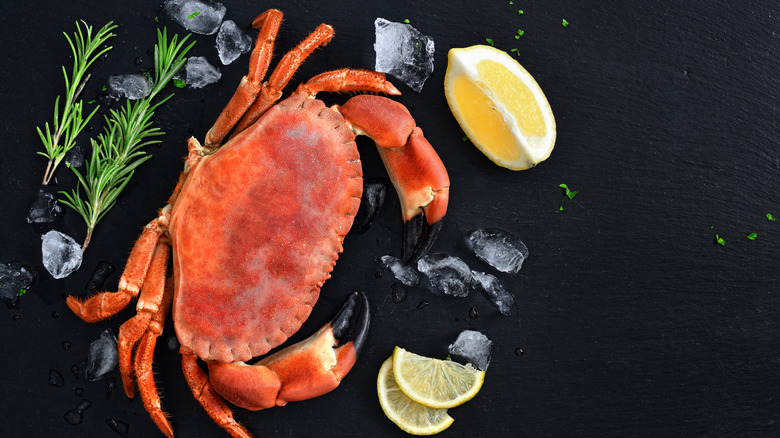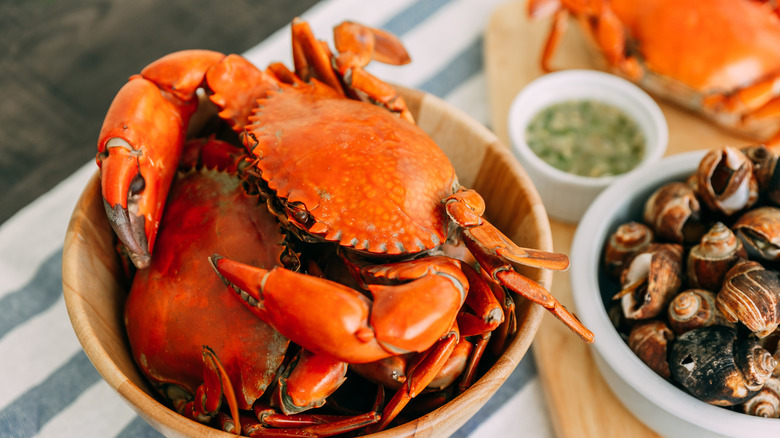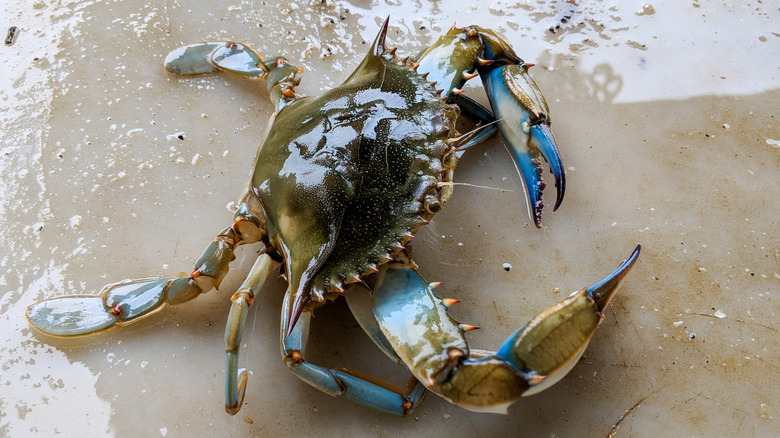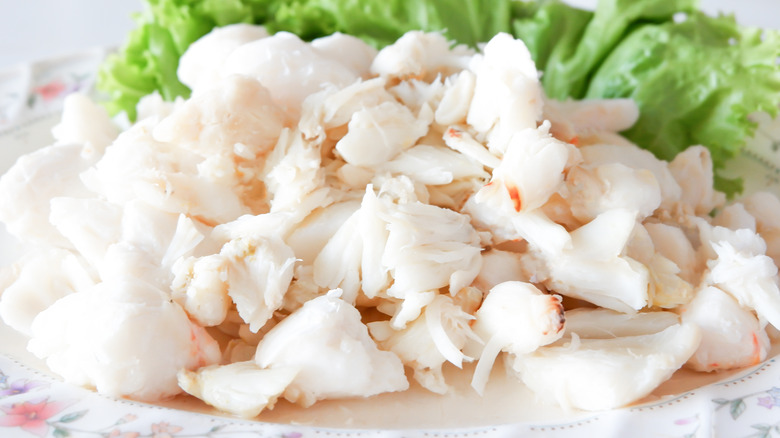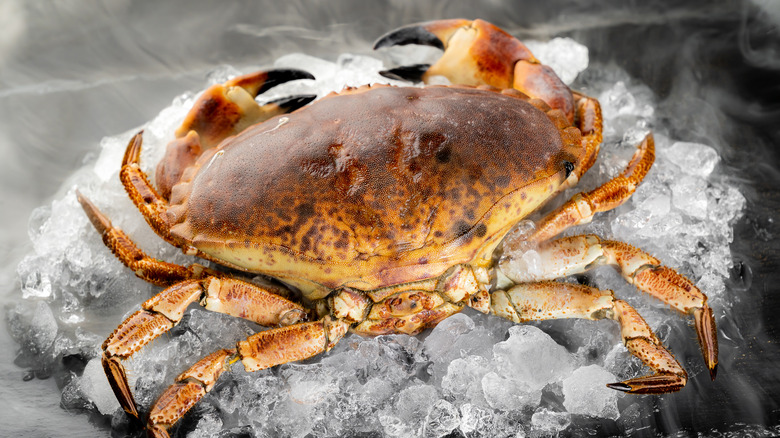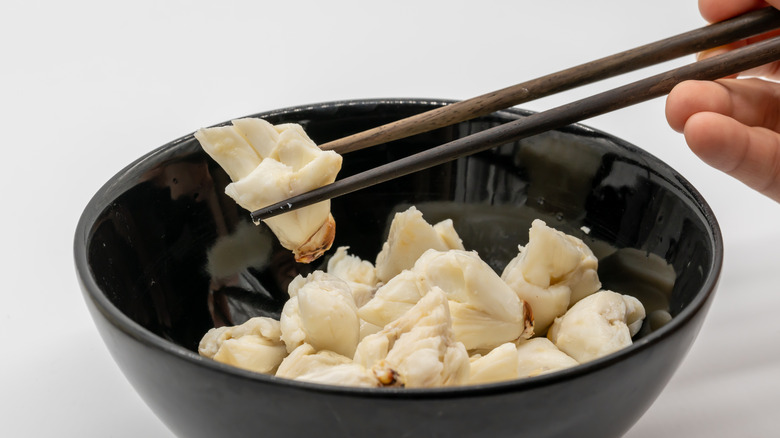What Is Rock Crab And How Do You Eat It?
If you have ever found yourself in America's Pacific Northwest and love seafood, chances are you have indulged in a rock crab or two. Typically known as the Pacific red rock crab, red rock crabs, or Cancer productus, the species commonly appears along the West Coast, and has been spotted all the way from Alaska to Mexico, per Biodiversity of the Central Coast.
Many imagine crabs as being bright red — the color all crabs turn once cooked, no matter what they look like while alive (via Food & Wine). Red rock crab actually has a bright red color pre-cooking, typically sporting a medium-to-dark red shell with large claws tipped with black. According to California Sea Grant, the crab's location determines the depth of its color, as some rock crabs develop a yellow color to blend into sandy ocean beds. Consumption of rock crabs tends to be local, but this special delicacy is a delicious addition to the kitchen and everyone should get to know it.
What is rock crab?
Rock crab is plentiful along the Pacific Northwest coastline of the United States. Since this crab is smaller than its more famous relative, the Dungeness crab, and more challenging to extract its meat from its shell, it tends to get less attention (via Thai Ginger). Red rock crabs typically range in size from four to six inches across, though they can grow up to 10 inches across. Female crabs are slightly smaller than male crabs, and in certain seasons carry the bright red roe, or crab eggs, that serve as a primary ingredient in she-crab soup, a type of creamy seafood bisque, according to Food Network.
Although rock crabs are small, they boast giant front crusher claws that contain a fair amount of meat. Since the rest of the body is small, most recipes using rock crab call primarily for this claw meat. Rock crabs, like other crustaceans, have sweet and delicate meat that's slightly briny in taste.
Rock crab vs. blue crab
Though found in the same waters as Dungeness crabs, red rock crabs can't really compare to those giant crustaceans thanks to rock crabs' smaller size (via Thai Ginger). Adult Dungeness crabs can weigh up to two pounds, while red rock crabs weigh less than half that. A more apt comparison is between the red rock crab and the blue crab, also known as Callinectes sapidus. Both of these crustaceans fall on the smaller side, meaning that it's more challenging to get a significant amount of crab meat out of them, per Southern Living. While the red rock crab has a very large front claw that contains most of the animal's flesh, the blue crab's two pincher claws are closer in size to each other.
The main difference between red rock crabs and blue crabs is where they come from. According to Cameron's Seafood, blue crabs appear most commonly throughout the southeastern U.S., especially in the Chesapeake Bay area. These boiled crabs are usually dumped out onto newspaper and picked apart with a hammer before eating. Meanwhile, rock crab is local to the West Coast, and can get prepared in a variety of ways.
How to cook rock crab
Most rock crab meat is found within its two large crusher claws, so make sure to focus on this part of the crustacean, should you choose to cook this critter at home (via The Infinite Kitchen). You can prepare the claws of the red rock crab just like a stone crab too. Crab claws are typically steamed and served with drawn butter; the firm, sweet meat needs little else to complement it. If you want to spice up your seafood, some more adventurous recipes call for a zingy mustard sauce in place of the butter, per Epicurious. You can also grill crab claws instead of steaming them; if you cook over a charcoal grill, the meat takes on a subtly smoky flavor (via Fresh Stone Crabs).
Rock crab bodies don't host much meat and it's generally a waste of time to try to extract any flesh from them. However, the bodies and legs can brew up into an exceptionally tasty crab stock. According to Food Network, this broth can serve as the rich base for tomato-based seafood stews such as cioppino. Crab stock also serves as a welcome addition to Southeast Asian soups and stews, such as Thai crab and coconut soup, according to Star Chefs.
Where to buy rock crab
Rock crab is not always the easiest crab catch to find. You might have a difficult time finding it outside of its Pacific Northwest environs, but if you happen to live or be traveling in and around Portland and Seattle you can likely find some rock crab at local seafood shops, as well as the fish counter at large grocery chains (via Crab-O-Licious). If you're game, you can also fish for rock crab yourself. Recreational rock crabbing typically involves baiting a hoop net with fish carcasses or frozen squid and is done around high tide, per The Fishing Advice.
As with all other seafood, rock crab should be eaten the same day you buy it or catch it. Otherwise, cook the crab claws, extract the meat, and store it in the freezer in an airtight container.
Rock crab nutritional information
One cup of rock crab meat contains 120 calories, 28 grams of protein, 2 grams of fat, and 110 milligrams of cholesterol (via My Net Diary). It's relatively high in sodium, coming in at 540 milligrams per cup. It has a little bit of calcium, about 120 milligrams, and 2.2 milligrams of iron.
Like other types of crab, rock crab contains long-chain Omega-3 polyunsaturated acids, according to Salcombe Finest. These types of fatty acids may protect against heart disease and aid brain development; some studies suggest that they also might inhibit aggressive behavior. Crabmeat also serves as a rich source of selenium, a mineral that helps prevent damage to the body's cells and tissues, and which plays an important role in the function of the immune system. For a great boost, you can't go wrong with rock crab and the nutrition packed inside.
